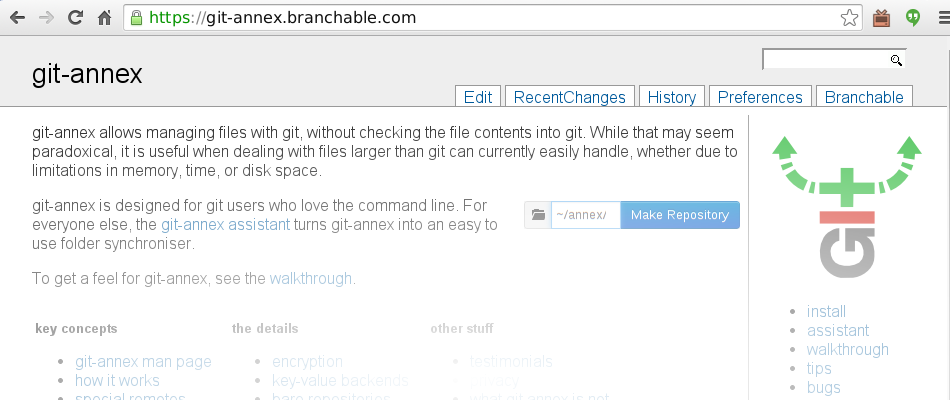

- #Git annex instead of dropbox how to
- #Git annex instead of dropbox software
- #Git annex instead of dropbox mac
OneDrive The best Dropbox alternative for Microsoft Office users. RESULT=`echo "$file" | sed "s/$STRING//"` Box An excellent Dropbox alternative for businesses. path "*(*'s conflicted copy -*" -print0 | while read -d $'' -r file do # XXX: use at your own risk - do not run without understanding this first!įind. It is available as a gist, and below in the body of this article. It might not be what you want, and it was designed to only work for me. When Bob needs access to some files, git-annex can tell him which drive (s) they're on, and. He can reorganize his files using that tree, committing new versions to git, without worry about accidentally deleting anything. Please look through, edit, and understand this script before running it. With git-annex, Bob has a single directory tree that includes all his files, even if their content is being stored offline. The script looks through the current working directory for “conflicted copy” matches, saves the unwanted versions (just in case) and then clobbers them with the good “conflicted” version. I spent some time with find and diff convincing myself that this was true, and eventually I wrote a script. These are the good versions, whereas in the example above file1 and file2.sh are the older unwanted versions. You’ll note that my previously clean file system now has the “conflicted copy” versions everywhere. | |- file2\ (james's\ conflicted\ copy\ ).sh | |- file1\ (james's\ conflicted\ copy\ )

My filesystem now looks like this: $ tree files/ Thankfully I have real backups, and, to be fair, Dropbox actually renamed my newer files instead of blatantly clobbering them. Today, the client decided that some of my newer files were older than the stored server-side versions, and promptly over-wrote my newer versions.

I periodically run the dropbox client to sync any changes to my public files up to their servers. but I probably would have still written git-annex instead of using it. However, the git-annex assistant is addressing some of the same needs in its own unique ways. Here’s how I saved my data.ĭropbox integrates with GNOME‘s nautilus to sync your data to their proprietary cloud hosting. git-annex is not a filesystem or Dropbox clone.
#Git annex instead of dropbox mac
Mac OS, FreeBSD and Windows - libmodbus/unit-test-server.
#Git annex instead of dropbox software
Finally, there are some hosted services that I use that don’t lock me in because I use them as push-only mirrors, and I only interact with them using Free Software tools. Instead of passing the context around to all your modbusxxx functions. Thirdly, there are every day Free Software tools such as Fedora GNU/Linux, Libreoffice, and git-annex-assistant which make my computing much more powerful. In addition, there are some excellent libre (and hosted) services such as WordPress, Wikipedia and OpenShift which don’t have the above problems. Git really does make these things incredibly easy.I usually avoid proprietary cloud services because of freedom, privacy and vendor lock-in concerns. I think this approach could be valuable for things like keeping personal documents or text files in version control (or indeed personal coding projects) without bothering to set up your own Linux box or server. Which will add your repository locally, and automatically set up a remote called dropbox which auto–merges with master. Git clone -o dropbox file://$HOME/Dropbox/repos/myrepo.git When you get to a computer that shares this Dropbox account, but hasn’t checked out Git yet, do as follows: This Git repository will now be available on all computers that your Dropbox account is. We’ve created the repository, linked a Git remote to it, and pushed the master branch to the repository. Git remote add dropbox file://$HOME/Dropbox/repos/myrepo.gitĪnd we’re done. Now we can add the new remote to our existing repository (again, assuming it lives at ~/Projects/myrepo). Basically we made a bare repository in the Dropbox directory. Please note these instructions should be mostly *Nix agnostic-but they’re only tested on OS X.įirst, create the Git repository in Dropbox (assuming your repository is named myrepo):Īnd that’s the repository created. Basically, we’re just going add a new remote which points at Dropbox (in the same way the origin remote typically points at your primary external repository). I’ve had a slight epiphany since then: what if I just used the awesome Dropbox (my referral link, if you’re likely to sign up) to share Git repositories between computers? Dropbox seems able to get through most corporate firewalls (my previous employer blocked SSH, for example), and is very unobtrusive in its synchronisation behaviour.Įnough introductions, make with the commands
#Git annex instead of dropbox how to
So last month I wrote a bit about setting up your own personal Git repositories on a Linux box, and how to use that for sharing code.

Git remote add dropbox file://$HOME/Dropbox/RipeApps/Git/newname.git


 0 kommentar(er)
0 kommentar(er)
